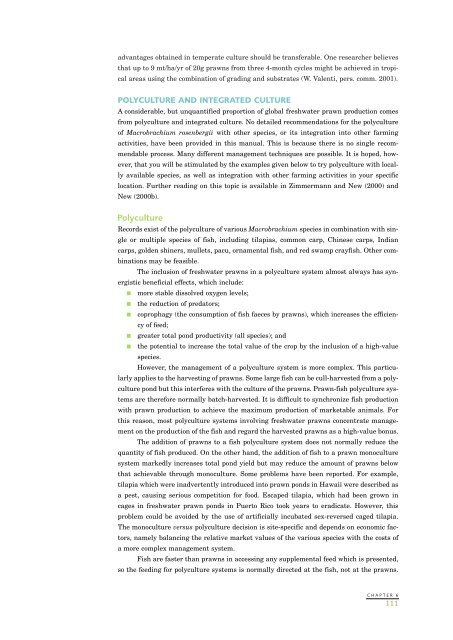You also want an ePaper? Increase the reach of your titles
YUMPU automatically turns print PDFs into web optimized ePapers that Google loves.
advantages obtained in temperate culture should be transferable. One researcher believesthat up to 9 mt/ha/yr of 20g <strong>prawns</strong> from three 4-month cycles might be achieved in tropicalareas using the combination of grading and substrates (W. Valenti, pers. comm. 2001).POLYCULTURE AND INTEGRATED CULTUREA considerable, but unquantified proportion of global <strong>freshwater</strong> prawn production comesfrom polyculture and integrated culture. No detailed recommendations for the polycultureof Macrobrachium rosenbergii with other species, or its integration into other farmingactivities, have been provided in this manual. This is because there is no single recommendableprocess. Many different management techniques are possible. It is hoped, however,that you will be stimulated by the examples given below to try polyculture with locallyavailable species, as well as integration with other farming activities in your specificlocation. Further reading on this topic is available in Zimmermann and New (2000) andNew (2000b).PolycultureRecords exist of the polyculture of various Macrobrachium species in combination with singleor multiple species of fish, including tilapias, common carp, Chinese carps, Indiancarps, golden shiners, mullets, pacu, ornamental fish, and red swamp crayfish. Other combinationsmay be feasible.The inclusion of <strong>freshwater</strong> <strong>prawns</strong> in a polyculture system almost always has synergisticbeneficial effects, which include:more stable dissolved oxygen levels;the reduction of predators;coprophagy (the consumption of fish faeces by <strong>prawns</strong>), which increases the efficiencyof feed;greater total pond productivity (all species); andthe potential to increase the total value of the crop by the inclusion of a high-valuespecies.However, the management of a polyculture system is more complex. This particularlyapplies to the harvesting of <strong>prawns</strong>. Some large fish can be cull-harvested from a polyculturepond but this interferes with the culture of the <strong>prawns</strong>. Prawn-fish polyculture systemsare therefore normally batch-harvested. It is difficult to synchronize fish productionwith prawn production to achieve the maximum production of marketable animals. Forthis reason, most polyculture systems involving <strong>freshwater</strong> <strong>prawns</strong> concentrate managementon the production of the fish and regard the harvested <strong>prawns</strong> as a high-value bonus.The addition of <strong>prawns</strong> to a fish polyculture system does not normally reduce thequantity of fish produced. On the other hand, the addition of fish to a prawn monoculturesystem markedly increases total pond yield but may reduce the amount of <strong>prawns</strong> belowthat achievable through monoculture. Some problems have been reported. For example,tilapia which were inadvertently introduced into prawn ponds in Hawaii were described asa pest, causing serious competition for food. Escaped tilapia, which had been grown incages in <strong>freshwater</strong> prawn ponds in Puerto Rico took years to eradicate. However, thisproblem could be avoided by the use of artificially incubated sex-reversed caged tilapia.The monoculture versus polyculture decision is site-specific and depends on economic factors,namely balancing the relative market values of the various species with the costs ofa more complex management system.Fish are faster than <strong>prawns</strong> in accessing any supplemental feed which is presented,so the feeding for polyculture systems is normally directed at the fish, not at the <strong>prawns</strong>.CHAPTER 6111
















